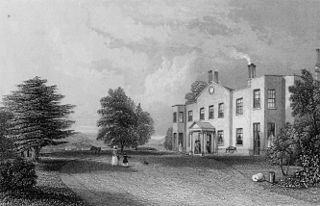 | |
| Industry | Construction |
|---|---|
| Founded | 1810 |
| Defunct | 1976 |
| Fate | Acquired |
| Successor | Tarmac |
| Headquarters | London, UK |
Key people | Lord Ashcombe (Chairman) |
Holland, Hannen & Cubitts was a major building firm responsible for many of the great buildings of London.
 | |
| Industry | Construction |
|---|---|
| Founded | 1810 |
| Defunct | 1976 |
| Fate | Acquired |
| Successor | Tarmac |
| Headquarters | London, UK |
Key people | Lord Ashcombe (Chairman) |
Holland, Hannen & Cubitts was a major building firm responsible for many of the great buildings of London.

The company was formed from the fusion of two well-established building houses that had competed throughout the later decades of the nineteenth century but came together in 1883: this was implemented by Holland & Hannen acquiring Cubitts, a business founded by Thomas Cubitt some 70 years before. [1] During the Second World War the company was one of the contractors engaged in building the Mulberry harbour units. [2]
In the 1960s, when Lord Ashcombe was the Chairman of the company, it held a major stake in ACI Property Corporation, the developer for the Le Cartier Apartments in Montreal. [3]
The company was acquired by Drake & Gorham Scull [1] in 1969 and then by Tarmac in 1976 and subsequently integrated into Tarmac Construction. [4]
The combined business went on to construct many important buildings and structures including the Holborn Bars in High Holborn completed in 1906, [5] the Cunard Building in Liverpool completed in 1917, [6] the Cenotaph in London completed in 1920, [7] County Hall, London completed in 1922, [8] Ironmongers' Hall completed in 1925, [1] Unilever House completed in 1930, [9] South Africa House in London completed in 1933, [1] the Senate building of the University of London completed in 1937, [1] the Royal Festival Hall in London completed in 1951, [1] the Roxburgh Dam in New Zealand completed in 1956, [1] New Zealand House in London completed in 1961, [1] the West London Air Terminal completed in 1963, [10] and Trawsfynydd nuclear power station completed in 1965. [1]

Pimlico is an area of Central London in the City of Westminster, built as a southern extension to neighbouring Belgravia. It is known for its garden squares and distinctive Regency architecture. Pimlico is demarcated to the north by Victoria Station, by the River Thames to the south, Vauxhall Bridge Road to the east and the former Grosvenor Canal to the west. At its heart is a grid of residential streets laid down by the planner Thomas Cubitt, beginning in 1825 and now protected as the Pimlico Conservation Area. The most prestigious are those on garden squares, with buildings decreasing in grandeur away from St George's Square, Warwick Square, Eccleston Square and the main thoroughfares of Belgrave Road and St. George's Drive. Additions have included the pre–World War II Dolphin Square and the Churchill Gardens and Lillington and Longmoore Gardens estates, now conservation areas in their own right. The area has over 350 Grade II listed buildings and several Grade II* listed churches. At the western edge of Pimlico, on the borders of Chelsea, Pimlico Road has become known in recent years for its interiors and design stores.

Thomas Cubitt was a British master builder, notable for his employment in developing many of the historic streets and squares of London, especially in Belgravia, Pimlico and Bloomsbury. His great-great-great-granddaughter is Queen Camilla.

County Hall is a building in the district of Lambeth, London that was the headquarters of London County Council (LCC) and later the Greater London Council (GLC). The building is on the South Bank of the River Thames, with Westminster Bridge being next to it, to the south. It faces west toward the City of Westminster and is close to the Palace of Westminster. The nearest London Underground stations are Waterloo and Westminster. It is a Grade II* listed building.
The year 1920 in architecture involved some significant events.
The year 1855 in architecture involved some significant architectural events and new buildings.
John Laing Group plc is a British investor, developer and operator of privately financed, public sector infrastructure projects such as roads, railways, hospitals and schools through Public-Private Partnership (PPP) and Private Finance Initiative (PFI) arrangements. It was listed on the London Stock Exchange and was a constituent of the FTSE 250 Index until the court approved the acquisition of the company by KKR in September 2021.

Mowlem was one of the largest construction and civil engineering companies in the United Kingdom. Carillion bought the firm in 2006.

The Hilton London Paddington, formerly the Great Western Royal Hotel, is a hotel that forms part of the Paddington Station complex in London, England. The hotel was originally the idea of Isambard Kingdom Brunel, who was the hotel's first managing director. The funding came in large part from the Directors of the Great Western Railway Company, who were persuaded by Brunel to buy shares in the project. The hotel was built on Praed Street in the early 1850s and opened on 9 June 1854 by H.R.H. The Prince Albert, Prince Consort, having taken 14 months to build. The hotel was designed by architect Philip Charles Hardwick, costing approximately £60,000 including all furnishing and fittings - a building which was 'to rival the facilities of the great hotels on the Continent'. The building effectively forms the main façade of the station, closing off the end of the train shed at the head of the terminal platforms. It was built by Messrs Holland Hannen & Cubitts, the building firm founded by Thomas Cubitt.

William Cubitt, lord mayor of London, was an English engineering contractor and Conservative Party politician.

BAM Nuttall Limited is a construction and civil engineering company headquartered in Camberley, United Kingdom. It has been involved in a portfolio of road, rail, nuclear, and other major projects worldwide. It is a subsidiary of the Dutch Royal BAM Group.
Tarmac Group Limited was a British building materials company headquartered in Wolverhampton, United Kingdom. It produced road surfacing and heavy building materials including aggregates, concrete, cement and lime, as well as operating as a road construction and maintenance subcontractor.

Henry Edward Cubitt, 4th Baron Ashcombe, was a British peer. He was the son of Roland Cubitt, 3rd Baron Ashcombe, and Sonia Rosemary Keppel, and the uncle and godfather of Queen Camilla.

Cardiff Docks is a port in southern Cardiff, Wales. At its peak, the port was one of the largest dock systems in the world with a total quayage of almost 7 mi (11 km). Once the main port for the export of South Wales coal, the Port of Cardiff remains active in the import and export of containers, steel, forest products and dry and liquid bulks.
Cubitt is a surname, and may refer to:
Guy Hartcup was an author and military historian. His published works focused on the history of 20th-century military technology.
Sir Lindsay Parkinson & Company Ltd, commonly known as Sir Lindsay Parkinson & Co. Ltd or Lindsay Parkinson was a civil engineering company in the UK. It was responsible for the construction of a significant part of the UK motorway network including elements off the M4 and the M6. It was acquired by Leonard Fairclough & Son in 1974.

Holborn Bars, also known as the Prudential Assurance Building is a large red terracotta Victorian building on the north side (138–142) of Holborn in Camden at the boundary of the City of London, England. The block is bounded by Holborn to the south, Brooke Street to the west, Leather Lane to the east and Beauchamp Street to the north. It is currently occupied by De Vere Venues and also the London office of English Heritage at 1 Waterhouse Square.

Cubitt was a British motor vehicle manufactured in Aylesbury, Buckinghamshire from 1920 to 1925. Around 3,000 vehicles were built.

Denbies is a large estate to the northwest of Dorking in Surrey, England. A farmhouse and surrounding land originally owned by John Denby was purchased in 1734 by Jonathan Tyers, the proprietor of Vauxhall Gardens in London, and converted into a weekend retreat. The house he built appears to have been of little architectural significance, but the Gothic garden he developed in the grounds on the theme of death achieved some notoriety, despite being short-lived. The estate was bought by Lord King of Ockham following Tyers's death in 1767, and the macabre artefacts he had installed, including two stone coffins topped by human skulls, were removed.

Melville Dundas was a major Scottish construction company.